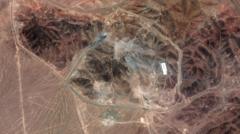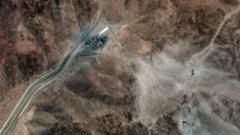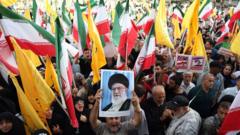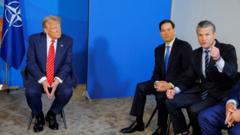In a contentious backdrop of conflicting intelligence reports, CIA Director John Ratcliffe stated that recent US airstrikes have significantly impaired Iran's nuclear capabilities, a claim that has reignited debates on the ongoing tension between the two nations.
CIA Chief Claims Significant Damage to Iran's Nuclear Facilities

CIA Chief Claims Significant Damage to Iran's Nuclear Facilities
CIA Director asserts airstrikes inflicted severe damage, contradicting earlier Pentagon assessments.
The head of the CIA has proclaimed that the US military strikes targeted at Iran's nuclear facilities have led to "severe damage," potentially hampering Iran's nuclear ambitions for years to come. This assertion, however, has sparked controversy as it contrasts sharply with a leaked preliminary assessment from a Pentagon intelligence agency, which claimed that essential components of Iran’s nuclear program remained largely intact despite the bombings.
Ratcliffe indicated that the military actions resulted in the destruction of several key Iranian nuclear sites but did not go so far as to declare that Iran's nuclear program had been completely neutralized. His comments come after President Trump reiterated the success of the airstrikes, labeling them as "obliteration." The President took to social media, disputing the integrity of reports suggesting that the impact of the strikes was minimal and announcing a forthcoming press briefing at the Pentagon to clarify the operations' outcomes.
During a NATO summit in The Hague, Trump emphasized the gravity of the strikes, describing the consequences as very severe, further hinting at upcoming negotiations with Iran to address its nuclear pursuits. Although Iran has not confirmed the existence of ongoing dialogues, US Middle East envoy Steve Witkoff reported that there have been channels of communication open between American and Iranian officials.
Ratcliffe's comments reflect information derived from a source deemed historically reliable and indicated that rebuilding the damaged nuclear facilities would take years. The strikes involved an impressive coordination of 125 military aircraft targeting Iran’s primary nuclear sites on Saturday. Satellite images have revealed extensive damage, featuring craters around key locations such as Fordo and Isfahan.
In another twist, a leaked report from the Pentagon's Defense Intelligence Agency minimized the airstrikes' impact, estimating a setback for Iran's nuclear ambitions of only a few months, a conclusion reached with low confidence according to defense officials. The Director of National Intelligence, Tulsi Gabbard, supported Trump's assertions, stating that Iran would face substantial hurdles in any reconstruction efforts.
While the Iranian government has acknowledged damage to its nuclear installations, Iranian foreign ministry spokesman Esmail Baghaei did not provide specifics on the extent of the destruction. At the same time, reports from the Israeli Atomic Energy Commission asserted that the strike severely damaged critical infrastructure at Fordo, potentially delaying Iran’s nuclear timeline significantly.
Despite these claims, Iranian officials, including Mehdi Mohammadi, an adviser to the Iranian parliament, maintained that no irrevocable harm was done to their facilities, underscoring the complexity and volatility of the situation. With Iran’s history of asserting that its nuclear program is for peaceful purposes, the global community continues to grapple with the contradictory assertions coming from both American and Iranian sources amid rising geopolitical tensions.























